The Story of Ford, Ferrari, Lola and LeMans.
Among the legions of performance cars that have prowled the streets of Miami, there’s one that stands avoe them all — if you’re lucky enough to catch a glimpse of one. A car that challenged “unbeatable” Ferrari — and won. Then said goodbye.
With the next generations of Ford GTs make the scene today (with a price tag of around $450,000+), we’d like to pay homage to the bold, balls-to-the-wall engineers at Ford Motor Company who developed the groundbreaking original design — the GT40 — a four-time winner of the 24 Hours of Lemans (1966 – 1969), including finishing first, second, and third in 1966. Those Ford dudes ruled!
The fact is, there’s the Ford GT40 — and then there’s everything that came after. The styling was sleek and low, the body lovingly designed around that huge V8 rocket engine. The sound…was unreal. The supercars of today owe a lot to the engineering, styling and technological advanced introduced by the GT40.
Ferrari, Porsche, Jaguar, Bentley. Alfa-Romeo. Racing heritage means a lot. From these proving grounds came revolutionary mechanical technologies — and the Ford GT40 and its family have been innovating since the first 40 was built. All that history is in the cockpit when you strap into a GT. It’s the car that beat the world.
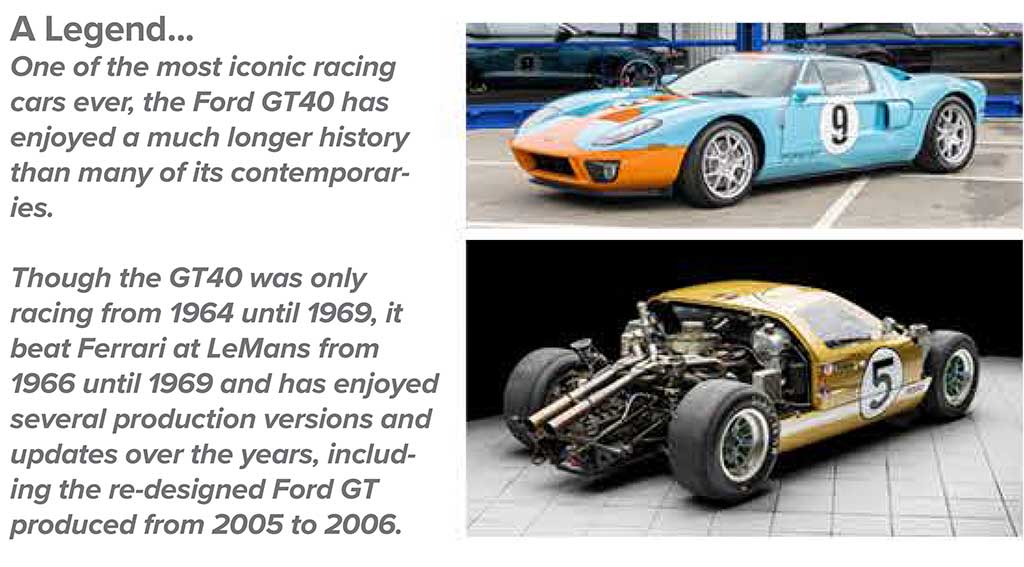
HOW THE GT40 HAPPENED
The Early 1960s and Carroll Shelby
The 24 Hours of LeMans race was the benchmark for automotive performance in the early 1960s. Ford, eager to build a supercar that would compete — and dominate — the famed 24-hour race, invested heavily in the GT40. In 1963, Ford and Ferrari struck the deal “that
never was,” with Ferrari pulling out of the deal, reportedly over a dispute involving Ford and the Indy 500. A newswire released on May 22, 1963 noted, “Ford Motor Company and Ferrari wish to indicate, with reference to recent reports of their negotiations toward a
possible collaboration that such negotiations have been suspended by mutual agreement.” Ford was not deterred. They negotiated with both Lotus and Lola before deciding to go with Lola — another ill-fated relationship that ended badly.
Enter Carroll Shelby. The man tasked to fix the GT40. The first job was to identify a team that could build the cars. As project engineers, they chose Eric Broadley, whose Lola GT was considered groundbreaking, and John Wyer, who had won Le Mans with Carroll Shelby driving for Aston Martin as the race manager. Shelby installed a 7-liter NASCAR engine that was more powerful and more reliable. The result was a vehicle that was much more stable and quicker than the Mark I.
Shelby and his team represented perhaps the most important landmark in the history of the Ford GT. Between 1966 and 1969, the GT40 went on to win the Le Mans four times in a row, carving its place in racing history and elevating Carroll Shelby to legendary status.
For the GT40, it was off to the races.
Shelby enlisted New Zealander Bruce McLaren as the initial test track driver. Early issues with the car were apparent as the Ford Motor Company team tried to accomplish in 10 months what Ferrari had perfected over decades. By April the first car was completed, and was quickly shipped to New York to be used for a press conference prior to the Mustang launch. During the time trials in Le Mans in mid-April, the car’s speed was tremendous, but the aerodynamics needed work as it was diffifficult to control at high speeds. With McLaren doing the development driving, a spoiler was added and other modifications made. The car was now as ready for racing as it could be for the 1964 season, and the team was aware of its limitations.
While it was overall a disappointing year, it sparked an unmatched era of innovation and experimentation that would make racing history. It was the beginning of a Carroll Shelby/Ford GT40 dynasty. Ford vs Ferrari (and everybody else) was underway.
THE MAKING OF AN AUTOMOTIVE LEGEND
A Short History of the Ford GT40
The Mk I: The Early 1960s – Building the Beast
The Mk I model, which was first introduced in 1964, was the first GT40 built after prototype testing. Sporting the muscular “Ford GT” styling, wedge-shaped front end, square headlights (with aerodynamic plastic covers), low-slung, 40.5-inch-high roof (the meaning of the “40” in “GT40”), and drop-off tail section. Its design was one of the marvels of the 1960s. While the Mk I featured the dramatic, swooping body design and aluminum chassis, it was plagued with mechanical limitations.
Ford built just five GT40 prototypes in 1964. The first, GT/101, premiered at the 1964 New York International Auto Show — and the GT/102 — were both scrapped after being used in crash testing — the results of these tests were critical in making safety improvements to the later prototypes.
1964 Engine horsepower and torque curve for Ford GT40 Mk I (street version): The 2-door fastback coupe body, V-8 288.5 cui, 340 PS with 335 hp.
The Mk II: The Carroll Shelby Era.
The Mk II: A Spectacular Showing in 1965
Glory year. The Mk II GT40 represents the pinnacle of engineering, performance and imagination for the era. This was the Carroll Shelby era and the GT40 Mk II (known officially as the “GT40X”) was the carbuilder’s most successful model. Shelby loved the look of the GT40, but saw a slew of challenges under the hood. The Shelby team quickly went to work on the mechanical problems, and had the MK II ready just in time for the 1967 Daytona race. It was a clutch performance by the GT40 team. Interestingly, the GT40 Mk II was identical to the Mk I with a different drivetrain. In fact, the MK I actually ran with the Mk II’s drivetrain in the 1965 24 Hours of Le
Mans. While the Mk II didn’t officially go into production until after the 1965 Le Mans race, it enjoyed immediate success, finishing first, second, third and fifth in the 1966 12 Hours of Sebring. Shelby, Ford and the GT40 Mk II were on top.
The Mk III: Setback in ‘66
A Rocky Road From Race Track to Daily Drive.
Can the GT40 be civilized? The Mk III became the black sheep of the GT40s, detuned for the street and and representing a stark departure from the Le Mans models. With a 289 cubic-inch engine, and now 8 inches longer than the racing model — with four round headlights, modified engine-cooling vents, and Borrani wire wheels — the Mk III stunned the auto industry. The interior was also a complete re-work, as the engineers scrambled to adapt the cockpit for daily driving, including the changeover to left-hand drive. The MK III was wideLy considered to be the dark ages for the GT40.
The Mk IV: A Swan Song for the GT40
The Late 60s and the Finish Line
The MK IV GT40 was built on an experimental chassis, giving it a vastly different look than any previous GT40. The MK IV had a snubbed front end and a much longer rear end. This marked the first time that the GT40 featured a NASCAR-like steel roll cage and it was 600 pounds heavier than its Ferrari rivals, but the Mk IV featured a huge 427 cubic-inch engine and that car won the only two races it ran that year – the 1967 12 Hours of Sebring and the 1967 24 Hours of Le Mans. In a dramatic finish to the ‘67 LeMans, three of the seven Ford vehicles crashed during the night hours. When the sun rose, it was a GT40 driven by Gurney/Foyt that beat out the 2nd and 3rd place Ferraris by just four laps. The checkered flag would not only be the end of the race, it signaled the beginning of the end for the Ford GT40 race program.
Ford had proven that Ferrari could be beaten and an American team and car could win at Le Mans. Ford left international sports racing, while the Gulf Oil Company continues to provide sponsorship during the 1968 Le Mans season. In 1969 new FIA rules and
regulations ultimately retired the GT40s from racing and ended the remarakable winning streak.
Following the 1969 model year, the GT project was shut down — GT40 production ended with just 107 cars, ending its impressive run.
The Baddest of All…
We’ll be on the lookout for the next-generation Ford GT. It’s the beauty we all behold. And a final thought: There are some amazing cars being built today. Electric cars like the Tesla, super luxury cars produced by Audi, Mercedes, Ferrari, Lambo, McLaren, BMW, and others — all wonderful. But the Ford GT is in a class by itself.










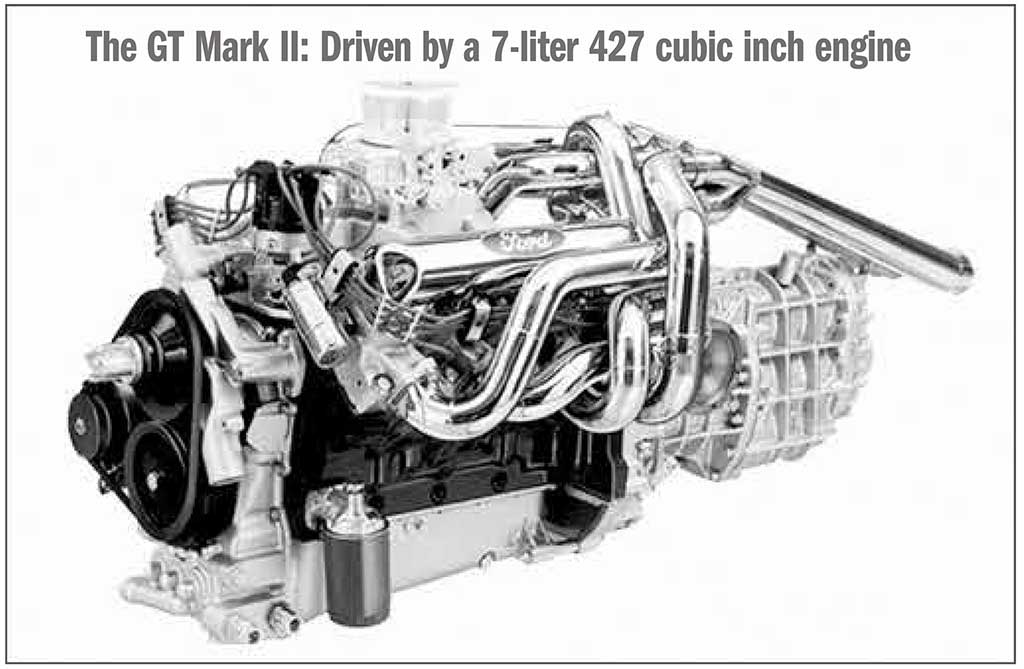
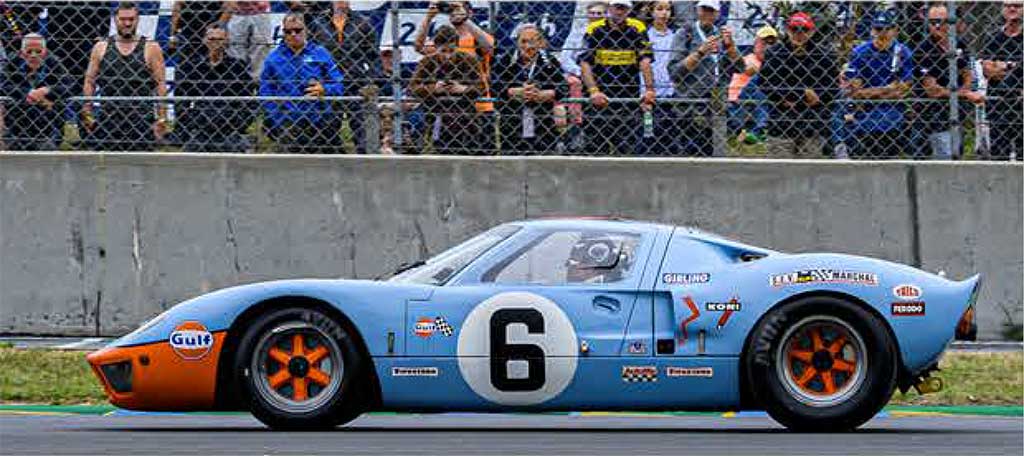
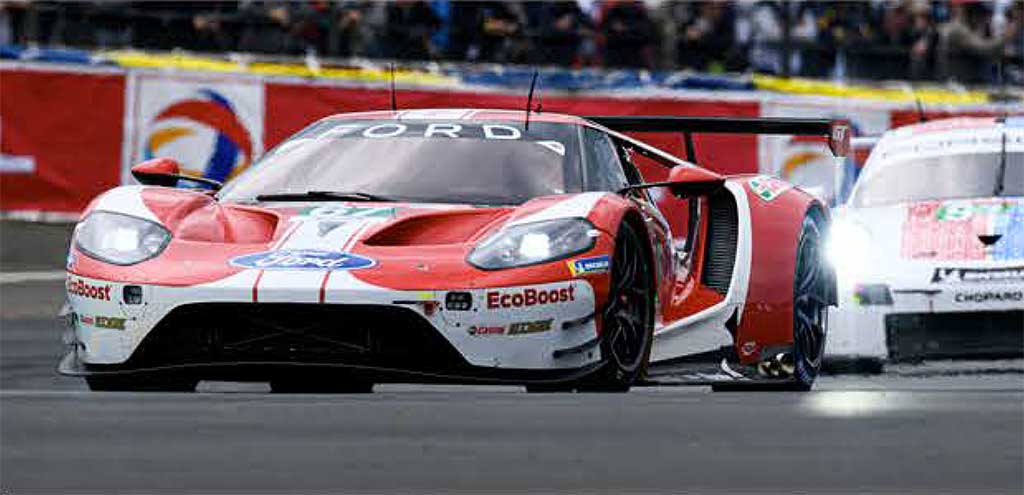
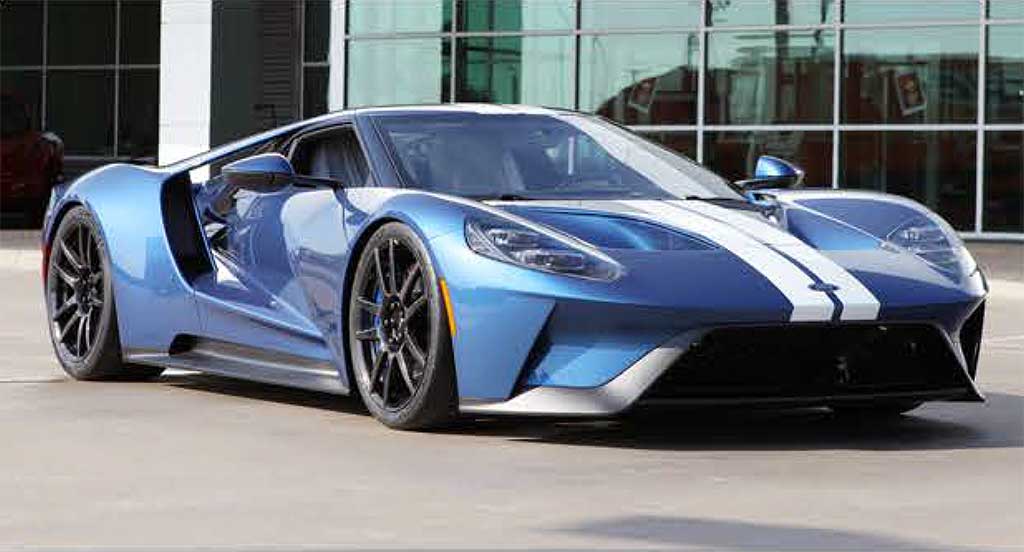
![– [ ] ☎️CALL NOW!! ????????
– [ ] (786)650-9456 #ydiaztowing
– [ ] ????Best Towing Service in Miami????
– [ ] .
– [ ] .
– [ ] .
…](https://www.miamicars.com/wp-content/uploads/2024/04/439880935_17874044664082011_820307467258220909_n-100x70.jpg)



![– [ ] ☎️CALL NOW!! ????????
– [ ] (786)650-9456 #ydiaztowing
– [ ] ????Best Towing Service in Miami????
– [ ] .
– [ ] .
– [ ] .
…](https://www.miamicars.com/wp-content/uploads/2024/04/439880935_17874044664082011_820307467258220909_n-324x160.jpg)

